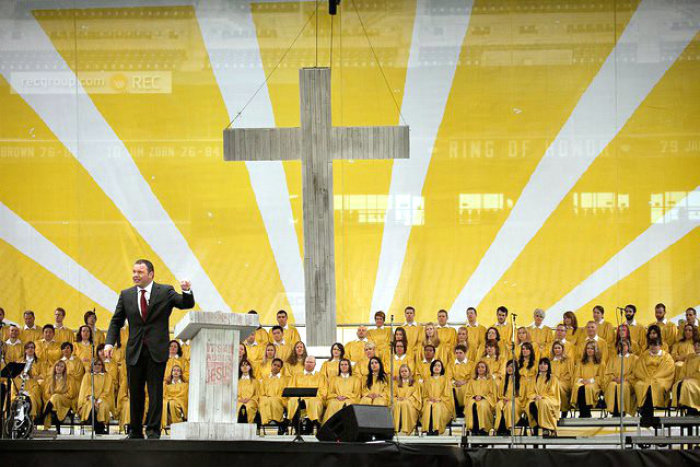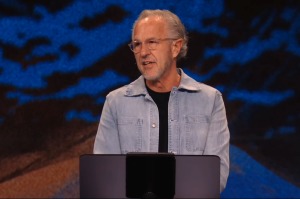How to Keep the 'Chreasters' Coming: Experts Say Preparedness and Follow-Up Are Key
While Churches Look to Make Converts for Christ on Easter Sunday, Many Fail to Make a Connection
As Christians gather this Sunday to celebrate the resurrection of Jesus Christ, many churches are pulling out elaborate props and Easter presentations in an effort to grow membership and make converts out of those "Chreasters," their friends, coworkers, family members and neighbors who attend service only on Christmas and Easter. But, according to experts, some congregations are woefully unprepared when it comes to connecting and keeping contact with their biannual guests.

Easter 2012 saw Pastor Ed Young of Fellowship Church in Grapevine, Texas, use a live lion and a lamb on stage during his open-air Sunday service, which drew a bit of criticism from local animal rights activists. This year, Pastor Mark Driscoll of Mars Hill Church in Seattle, Wash., plans to hold a record 42 services across his 14 campuses in four states and expects a huge number of converts to come to faith in Jesus Christ.
As an electrified Driscoll explains in a recent video announcement about Easter 2013, "Easter's coming. It's our biggest Sunday of the year! We get so excited for Easter Sunday. It's where we see the most people meet Jesus, the most people attend the church, the most people get baptized. So it is the day we are the most excited."
Yet the excitement surrounding Easter Sunday and the presentations and props used to help convey Christian beliefs about Jesus' resurrection often lose their "awesome" and "epic" flavor once the following Sunday rolls around. It is quite common, actually, for some pastors to find themselves wistfully watching the doors and hoping that at least one or two of the previous week's guests return with the intention of giving Jesus, or at least church, a try.
"You would be amazed at how few churches actually experience an increase," Yvon Prehn, founder and director of Effective Church Communications, told The Christian Post. "I have been teaching church communications for over 20 years and that's one of the biggest responses that I get – unless people are intentional about it – that they did not get the response that they thought they would."
Ed Stetzer, president of LifeWay Rearch, an expert in church planting and church growth and lead pastor at Grace Church, said in an email Wednesday to CP that, "Easter is an opportunity, but it has to be seized."
"More people will hear the message on this Sunday than any other of the year. If it is worth preparing a well-done service and great message, it is certainly worth following up with each and every person who attends."
Stetzer noted, however, that one of the biggest mistakes some churches make is failing to do just that.
He said that "churches need a way to gather names and contact info from people willing to give it, a plan to follow up those names with several points of contact (phone call, letter, invite card to come again), and a plan to connect them into a smaller group if they return."
Church communications consultant Prehn, who describes her work as helping churches to carry out the Great Commission by providing practical training in print and digital communications, has done dozens of seminars for Christian communities and leaders interested in making an impact on the unchurched during seasonal celebrations. The Southern California resident echoed Stetzer when sharing with CP her list of at least three things churches ought to consider to make a lasting connection with visitors, primary of which is making follow-up a top priority.
Prehn suggested a connection card that intentionally invites people to share their contact information.
"One of the best ways to do this is to just say, 'You know, we would just love to pray for you. We would consider that a privilege,'" suggested Prehn. "A very simple card. You don't want their life's history but just something where you can follow up. That's really important."

Second, she emphasized that churches should be upfront about how services are usually run – when the lion has been returned to the zoo and the 42 services are cut down to three. For this, Prehn said a bulletin insert should do the trick.
"Most churches totally space out on this," she said. "Some churches have a petting zoo or they have pre-lattes or they have a brunch, they do all this special stuff. Well, they don't do that every week. People bring a lot of friends and kind of the unspoken assumption is that if they like the church and they think we're cool and we really impress them and they love the worship music, they'll just come back next week to Sunday school and bring their kids."
Organizers should check that assumption since most Easter visitors, likely the unchurched, have no concept of church, she said.
"I strongly recommend something that says 'Here's what we do when it isn't Easter. We've got this for your kids, we've got a single's ministry here, we've got this stuff for women and here's our regular celebration services. You know something just really simple and upbeat that says 'When it isn't Easter, this is what we're doing,'" explained Prehn.
Finally, churches should encourage holiday visitors to ponder the meaning of the Resurrection Day message long after the service is over. Prehn suggested handouts for this as well, which she said should include URLs for "really good evangelistic websites" as well as a church contact or information about Bible study times.
"If you do those kinds of things, you form a link with people that can continue in the future," she said.
The overriding theme, said the church communications expert, is to remember that information and direction are most effective in helping new visitors feel at ease and get acclimated – which may mean altering or simplifying the traditional liturgy on this special day of the year.
"The [churces] that do things really well explain what they're doing as they go along. They don't assume that everybody knows the whole story. Churches that are so into their traditions...do things that are really confusing and don't explain them," said Prehn.
"Most churches have got it down these days on their music, their multimedia. It's the little things that are really frustrating and confusing to seekers," she added.
Both Stetzer and Prehn agreed that size doesn't really matter when it comes to making a lasting impact. Whether a megachurch or smaller congregation chooses to go for maximum sensory overload or decides instead to keep things simple, preparedness remains the key.
"It's basically about getting 'ready for company.' If you are having new people over, you make sure everything is ready. Well, lots of churches will have company on Sunday and churches of all sizes are getting ready," said Stetzer.
Prehn said every church should embrace its size and budget, adding that she believes "the Lord has all kinds of different churches."
"Just always be who you are and don't apologize for it," she added. "If you're a little church and you do things very simply, the Lord will draw to you people who want that. Not everybody wants these big, loud, flashing lights."
Despite it being quite common for churches to experience a "post-Easter bump," as Stetzer puts it, pastors nonetheless may find themselves nervous or afraid of seeing the congregation shrink.
The LifeWay Research president and missiologist added once more that a follow-up plan must be implemented if there is any hope, and there should be, of seeing repeat guests. He also stressed that churches should remember that everything doesn't happen at once and "that people do not move from being an Easter visitor to a growing disciple after one awesome Easter sermon."
"This is the start of a relationship with your church – and that needs to be cultivated," Stezter added. "Part of that cultivation is that they need to then hear about the gospel your churches preach. So, Easter is not a one-time deal. It is a step in the process."
Despite the odds of Easter guests returning to church the following week, statistics of which CP could not find, Prehn, not surprisingly, suggested that churches be prepared for that as well, perhaps with a follow-up sermon series that explains the Christian faith and answers questions possibly raised during Easter services.
But amid all the planning and presentations, Stetzer reminds pastors and their congregants to remain focused on the purpose of all their work.
"As pastors, it is so important that we don't get so caught up in the Easter work of the Lord that we forget the Lord of the work," said the LifeWay Research president.
Others, like Quest Church Pastor Eugene Cho, have added that instead of resorting to gimmicks to attract numbers, Christians should remember that, at the end of the day, the gospel is enough. And the primary concern among Christians, noted Pastor Rick Warren of Saddleback Church, should be making visitors feel loved more than "wowed."





























